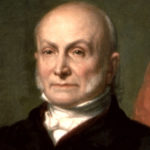 On February 21, 1848, Abraham Lincoln was attending proceedings in the House of Representatives, when suddenly, the Speaker of the House, Robert Charles Winthrop, was interrupted “by several gentlemen, who sprang from their seats to the assistance of the venerable John Quincy Adams, who was observed to be sinking from his seat in what appeared to be the agonies of death.” Adams was carried to the rotunda, and from there to the speaker’s room, where he remained until his last breath two days later. Lincoln would serve on the official House funeral arrangements committee for Adams, the former president and his House colleague during Lincoln’s sole term in Congress.
On February 21, 1848, Abraham Lincoln was attending proceedings in the House of Representatives, when suddenly, the Speaker of the House, Robert Charles Winthrop, was interrupted “by several gentlemen, who sprang from their seats to the assistance of the venerable John Quincy Adams, who was observed to be sinking from his seat in what appeared to be the agonies of death.” Adams was carried to the rotunda, and from there to the speaker’s room, where he remained until his last breath two days later. Lincoln would serve on the official House funeral arrangements committee for Adams, the former president and his House colleague during Lincoln’s sole term in Congress.
Lincoln had more in common with our sixth president then most people know. Like Lincoln, Adams was not a scientist himself but encouraged it, including writing a treatise on the reform of weights and measures. His nearly religious promotion of astronomical observatories helped create the study of astronomy in America, pushing in an 1843 oration the practical value of astronomy. He reminded humanity to look “heavenward” as if “the special purpose of their creation” was “observation of the stars.” During his tenure as a congressman following his presidency, Adams fought against both anti-British and antifederalist biases to get the Smithson bequest devoted to scientific research. Like Adams, Lincoln saw science and technology as something that could improve the lives of all Americans. He saw a mechanism by which all men could better their condition.
While Henry Clay, Lincoln’s “beau ideal of a statesman,” is best known as promoting the Whig’s “American System” of economic development that Lincoln spent most of his career espousing, it was Alexander Hamilton and John Quincy Adams who originally developed and drove the idea. They believed in modernizing the nation through government-supported “internal improvements,” as well as the establishment of a national bank to help finance these improvements, and high tariffs to protect American investment from cheap foreign goods.
Lincoln would later take up the mantle of John Quincy Adams, the man who had worked so hard to accept the money that made the Smithsonian Institution possible. Lincoln clearly came to rely on Smithsonian Secretary Joseph Henry’s expertise and made every effort to protect the Smithsonian during the war. Funding was always a problem, and in a November 11, 1862, letter to William Seward, Henry anxiously begged for Lincoln to grant power of attorney to a London law firm attempting to recover a part of the original bequest of James Smithson not yet received. Lincoln granted Henry’s request, and the remaining funds, approximately $25,000 in gold, were transferred. The Smithsonian would continue to exist.
Several months after John Quincy Adams’s death, Lincoln would make his way to Adams’s home turf in Massachusetts to give a series of stump speeches for the Whig presidential nominee, Zachary Taylor. Adams had lived a long public life beyond his presidency, dying at 80 years old. Lincoln would not survive six weeks beyond his second inauguration, his life taken by an assassin’s bullet at the age of 56.

Lincoln: The Fire of Genius: How Abraham Lincoln’s Commitment to Science and Technology Helped Modernize America is available at booksellers nationwide.
Limited signed copies are available via this website. The book also listed on Goodreads, the database where I keep track of my reading. Click on the “Want to Read” button to put it on your reading list. Please leave a review on Goodreads and Amazon if you like the book.
You also follow my author page on Facebook.
David J. Kent is President of the Lincoln Group of DC and the author of Lincoln: The Fire of Genius: How Abraham Lincoln’s Commitment to Science and Technology Helped Modernize America and Lincoln: The Man Who Saved America.
His previous books include Tesla: The Wizard of Electricity and Edison: The Inventor of the Modern World and two specialty e-books: Nikola Tesla: Renewable Energy Ahead of Its Time and Abraham Lincoln and Nikola Tesla: Connected by Fate.



 John Quincy Adams was the sixth president of the United States. What many people do not know is that after his presidency he was elected to the US House of Representatives, where he served for 18 more years. He died on February 23, 1848 on the House floor during Abraham Lincoln’s one term as a US Congressman. Lincoln served on Adams’s funeral committee.
John Quincy Adams was the sixth president of the United States. What many people do not know is that after his presidency he was elected to the US House of Representatives, where he served for 18 more years. He died on February 23, 1848 on the House floor during Abraham Lincoln’s one term as a US Congressman. Lincoln served on Adams’s funeral committee.






